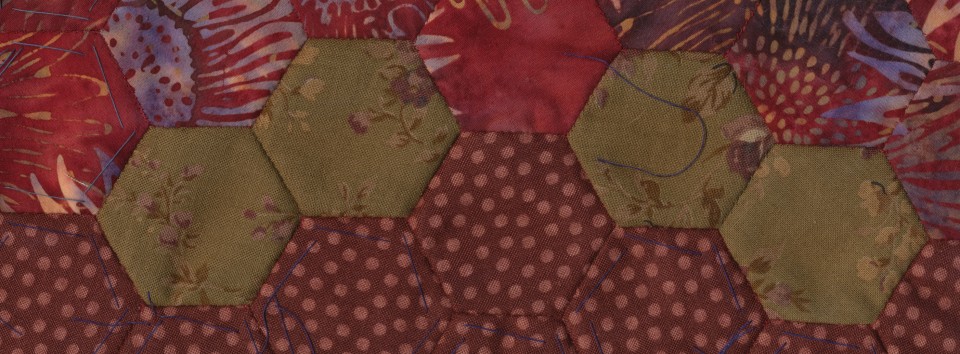At the March meeting of the Central Jersey Modern Quilt Guild one of the members brought in an unfinished vintage hexagon quilt top that she had obtained, probably at a flea market or thrift store. It was quite a find, and in fragile condition. I was in awe of the size of the hexagons used in the quilt, and was sorry that I had not managed to take some photographs of it.
The quilt captured my imagination and I thought about it a great deal. I especially thought about how having seen it had changed my perception of the scale of the work I am doing with one inch hexagons. I wasn’t positive, but I imagined that the piece was made using 1/2 inch hexagons, and I really wanted a closer look, and a few photos.
Luckily, the owner of the quilt top was persuaded to bring it back for the April meeting, and I managed to get some photos of it with my iPhone. The first photo shows the vintage quilt in the foreground with my own quilt top in the background. Immediately after taking the first photograph I realized that it didn’t represent the difference in scale well. Because objects closer in space in a two dimensional image appear to be larger than objects farther back in the image, the difference in scale of the two sizes of hexagons was not shown off to best advantage. That first image appears below.
I went on to take additional images with the quilts side by side, which better show the difference in scale. The hexagons in the vintage quilt were, in fact, 1/2 inch in size, half the size of my one inch hexagons.
The back of the vintage quilt shows that the artist used a variety of papers such as newspapers, pages of catalogues, and probably any type of paper available to her.
The design of this quilt uses a diamond shape with the same four hexagon unit that I have used in many of the pieces I have created in my first year of English Paper Piecing. Those four hexagon units are bordered by another fabric choice to create diamonds using two fabrics. The diamonds are joined with black solid fabric.
I am inspired by this quilt to create a similar quilt. I want to make something with 1/2 inch hexagons. I like the idea because it will be a long term project that I can do simultaneously with other projects. It will be something that I can carry with me when I travel, and the sewing kit for this project won’t take up much space for the amount of activity it will provide. This project will make it possible for me to make better use of my scraps because the 1/2 hexagon shapes won’t require very large pieces. Plus I can do something scrappy and traditional. I see myself using my beloved hunter green fabric to join the diamonds together, and I may create my diamonds using two fabrics, as was done in the vintage quilt. Either that, or I may choose a solid color to be used in the center of each diamond and make each diamond with three fabrics. That would be reminiscent of log cabin quilts that feature a red square in the center of each block. I haven’t decided yet, but I think I am leaning toward having a unifying central color, perhaps maroon to carry on with my preferred color pallet.



































































